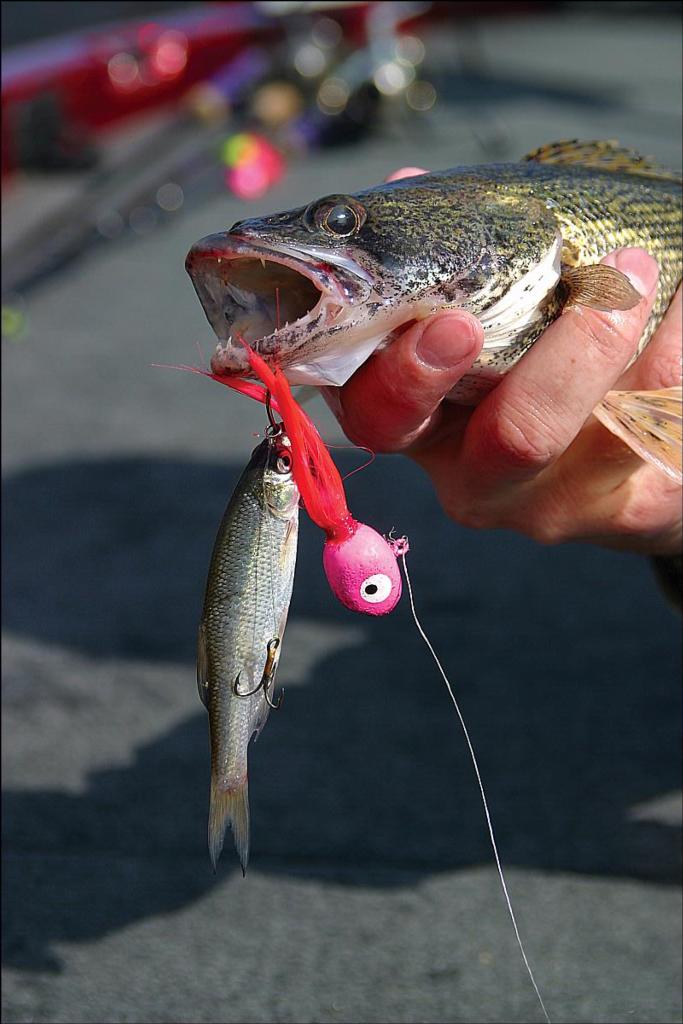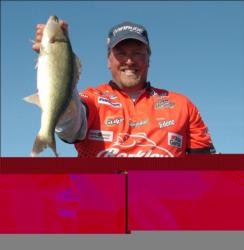Snap, tackle, pop
Snap-jigging triggers savage strikes

————————————–
Editor’s note: This article originally appeared in the April 2006 issue of FLW Outdoors Magazine.
————————————–
Just when you thought you had jigging down cold, it’s time to heat up the pace. Jigging for walleyes and saugers has traditionally been a slow, subtle, meticulous affair. Keep your line as short and vertical as possible to maximize feel and control. Use short, gentle, up-down strokes of the rod tip to alternately lift the jig a few inches, then let it fall back on a semi-taut line until it touches bottom. Avoid slack on the drop because that’s when walleyes usually strike. Watch for twitches in the line, or feel for minor changes by gripping the line with your index finger. Set the hook at the slightest suggestion that a fish may have touched the bait. Tempt and tease ’em into biting.
Got all that? Good. Now forget it – at least for snap jigging.
Snap jigging is definitely against the ordinary walleye grain. It blends speed and erratic lure action to simultaneously cover water and force fish to respond to your lure. Even walleyes.
Snap jigging was developed on several large, windswept lakes in Northern Minnesota, where walleyes routinely move atop shallow, 4- to 8-foot flats to feed amidst the turbulence generated by wind action. To locate pods of roaming, active fish, anglers incorporate a quick forward boat motion, using either an electric motor on midrange speed or a small outboard at low throttle. Heck, you can even use your big console engine if you shift in and out of gear. The point is this is no creep-and-crawl. Get your boat moving forward at several miles per hour to cover serious territory.
Next, tie a jig on your spinning rod, using 8-pound-test mono. You want a little stretch to absorb the coming shock. And rather than downsizing to a teeny 1/16- to 1/8-ounce jig for shallow water, load up with a heavier 1/4-ouncer. Tip it with a small minnow for starters and then examine options later in the game.
OK, is the boat moving forward at a good clip? Good. Now cast your jig out behind the boat as far as you can, and let a little more line slip off the spool before engaging the bail. Next, point your rod tip straight back toward the jig, and when the line tightens, quickly snap the rod forward until the rod tip is straight out to the side. That’s right, a huge snap to shoot and sweep the jig forward several feet – well off the bottom.
That accomplished, immediately point the rod straight back at the jig, throwing oodles of slack into the line. This sends the jig from forward bullet mode into immediate free-fall, appearing suddenly helpless. The combination of shoot and parachute is too much for walleyes to resist. They sweep in and chomp down hard.
So how do you feel the strike? You don’t, most of the time. But the next time you sweep your rod tip forward, uggnnhhh! There’s something heavy on there. Fish on!
Cruise and weave atop shallow flats to determine a depth preference or area of fish concentration, alternately snapping forward and pointing back, making the jig scoot and drop. And get this: don’t worry about making bottom contact. Done properly, the jig seldom contacts bottom, working the mid-depth levels. As we said, throw tradition out the window. This ain’t your grandpa’s jigging style.
 Snap jigging works as a coverage and triggering method almost anywhere walleyes move atop shallow flats to feed: windswept reservoirs, flats in natural lakes, even shallow river stretches. But it even works deeper, too.
Snap jigging works as a coverage and triggering method almost anywhere walleyes move atop shallow flats to feed: windswept reservoirs, flats in natural lakes, even shallow river stretches. But it even works deeper, too.
Walmart FLW Walleye Tour pro Tommy Skarlis, an Iowa native who spent several years living in Walker, Minn., on the shores of humongous Leech Lake, knows the snap-jigging technique excels on expansive, shallow flats: “But I’ve used it elsewhere, too, like atop the big humps along Lake Erie’s southern shore. Get up on top of the hump, start snapping where you spot pods of walleyes on your electronics, and you’ll quickly start slamming fish.
“You can even drop down to the sides of the humps and trigger fish down as deep as 25 feet using this tactic, but you have to beef up your jig to 3/8 or 1/2 ounce to get it deeper. Fish suspended to the side will rise up and nail it.
“And you don’t need to use a minnow, either. I like tipping my jig with a 3- to 4-inch Berkley Power Minnow or Gulp Minnow, which shoots and scoots like a lively baitfish, then plummets. Man, they clobber it. I tip it on a Lindy Max Gap Jig to make sure there’s plenty of hook point exposed for a good bite. Or, if I decide I do need a minnow or to slow down a little in cold water, I’ll switch to a Lindy Fuzz-E-Grub, which has a small grub body and feather tail. This combo is excellent, too.”
Need to cover water and trigger strikes all at the same time? Snap to it! Snap jigging is the answer.